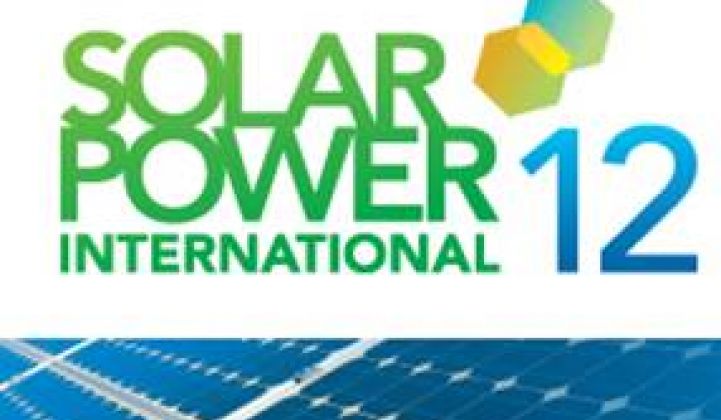Reporting from Solar Power International (SPI) 2012, the solar industry’s annual conclave.
Even before arriving in Orlando, Florida for the four-day trade show, educational conference, and networking extravaganza, GTM was seeing announcements indicating that solar manufacturers and developers are thinking about the potential strength in numbers.
The most ambitious effort spotted so far is the Clean Power Finance (CPF)-led effort to organize information contributed by solar industry installers and other stakeholders across the country into a National Solar Permitting Database.
CPF hopes to use a $3 million U.S. Department of Energy (DOE) grant and its own resources to create a comprehensive online database of local permitting standards. If the industry cooperates, CPF Senior Director of Government Programs James Tong believes, the database could lead to a cut in the balance of system (BOS) non-hardware (soft) costs of installing a five-kilowatt (DC) residential rooftop solar system of more than $0.22 per watt.
_540_449_80.jpg)
Burnham Energy, a national service provider for solar installers, and local jurisdictions across the country have acknowledged the value of the plan by contributing data. The industry is beginning to respond. Major players who have signed on include Paramount Solar, B.E. Solar, Sunwize Technologies and PvPermits. Real Goods (Nasdaq: RSOL) turned over data for 5,500 ZIP codes. Talks with REC Solar, Verengo, Vivint Solar, Sungevity, Next Step Living, SolarCity and others are ongoing.
It remains to be seen whether the biggest installers will forego private access to local bureaucracies and information that give them a competitive advantage from the current chaos.
Ampt’s High Definition (HD) PV Alliance is another example. Inverter partners KACO New Energy, REFUsol and LTi REEnergy, junction-box makers Shoal and Amphenol (NYSE: APH), solar module vendors Suniva, Zen China and Neopoli, and monitoring service providers meteocontrol and Deck have signed on.
The Alliance members get access to Ampt’s proprietary power conversion technology. Ampt gets a place in the system architecture and solar system builders get potentially impressive cost savings.
_540_449_80.jpg)
“By ourselves, Ampt would be challenged to provide these cost savings,” acknowledged Ampt Sales and Marketing VP Evan Vogel. The Alliance’s set of business partnerships is “an end-to-end pre-tested solution that is predictable and characterized,” Vogel said.
The Ampt device conditions solar panel power in commercial and utility-scale installations so that a 600-kilowatt inverter can turn a megawatt of DC to AC, Vogel explained. “The price of the box itself doesn’t change, but the dollars-per-watt on a system level go down 40 percent.”
Vogel said the Alliance is already a success and new partners are in the works. “They recognize the patented Ampt technology provides a unique ability to drive down system cost,” Vogel said, “and they want to be a part of it.”
Several solar panel manufacturers have noted to GTM plans to provide financing to installers who buy their product. They describe these plans as a type of program in which they are enrolling, or allying with, installer-partners. The goal is to create a larger resource for developers along the lines of Soligent's "catalog of products," a kind of "one-stop shopping," in the words of one CEO.
The idea is apparently an evolution of the third-party ownership model. It is also an effort for panel manufacturers, pressed by ferocious competition in a market where panels are still selling at prices below the cost of making them, to bind installers to them.
In order to endure this turbulent marketplace and move forward, they need their partners to realize that manufacturers and installers are in this together.
_540_449_80.jpg)



